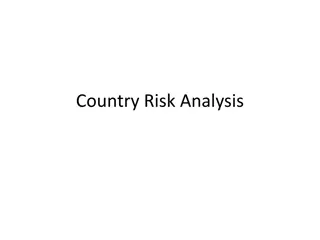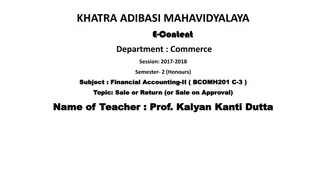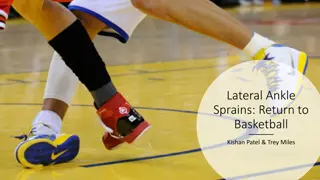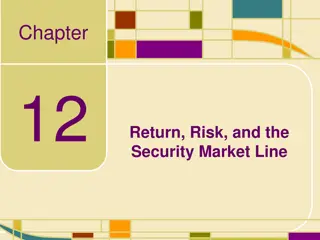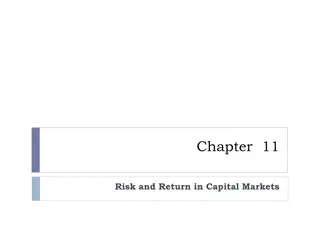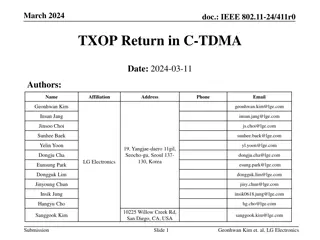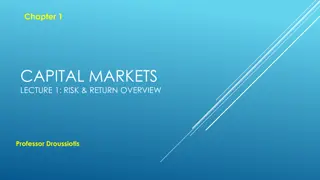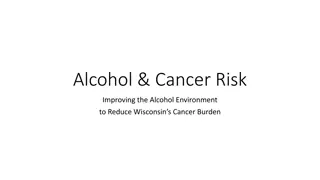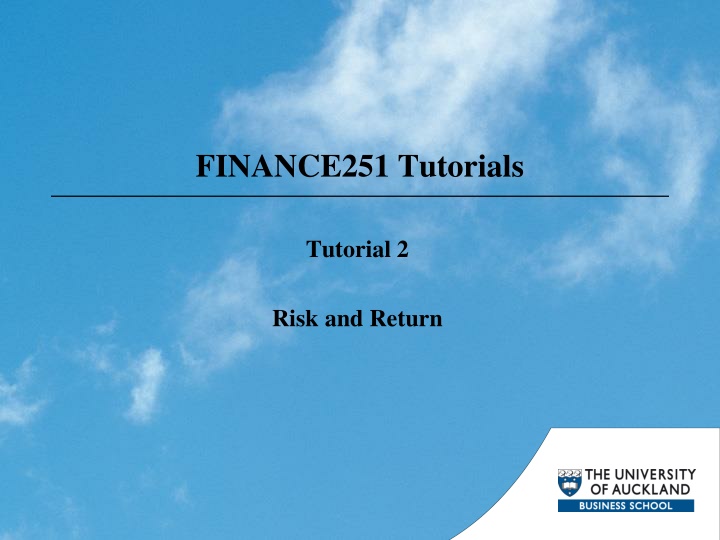
Risk and Return Analysis of Assets F, G, and H in Perth Industries
Explore the risk and return characteristics of assets F, G, and H in Perth Industries through calculations of expected return, standard deviation, and coefficient of variation. Determine which asset offers the highest expected return, greatest risk, and largest relative risk. Additionally, derive the betas for assets A and B graphically over a 10-year period.
Download Presentation

Please find below an Image/Link to download the presentation.
The content on the website is provided AS IS for your information and personal use only. It may not be sold, licensed, or shared on other websites without obtaining consent from the author. If you encounter any issues during the download, it is possible that the publisher has removed the file from their server.
You are allowed to download the files provided on this website for personal or commercial use, subject to the condition that they are used lawfully. All files are the property of their respective owners.
The content on the website is provided AS IS for your information and personal use only. It may not be sold, licensed, or shared on other websites without obtaining consent from the author.
E N D
Presentation Transcript
FINANCE251 Tutorials Tutorial 2 Risk and Return
Q1. Integrative - expected return, standard deviation, and coefficient of variation Three assets F, G, and H are currently being considered by Perth Industries. The probability distributions of expected returns for these assets are shown in the following table. a) Calculate the expected value of return, ?, for each of the three assets. Which provides the largest expected return?
Q1 continued Asset F Asset G Asset H P(r) 0.10 0.20 0.40 0.20 0.10 r E(r) 4% 2% 0% -1% -1% 4% P(r) 0.40 0.30 0.30 r E(r) 14% 3% -6% P(r) 0.10 0.20 0.40 0.20 0.10 r E(r) 4% 4% 4% 0% -2% 10% 40% 10% 0% -5% -10% 35% 10% -20% 40% 20% 10% 0% -20% Expected return = Expected return = 11% Expected return =
Q1 continued b) Calculate the standard deviation, r, for each of the three assets returns. Which appears to have the greatest risk? ? ri r2 P(ri) r= ?=1 Asset F Asset G Asset H (ri r )2 P(ri) 0.10 0.20 0.40 0.20 0.10 P(ri) 0.40 0.30 0.30 P(ri) 0.10 0.20 0.40 0.20 0.10 (ri r )2 (ri r )2 (0.40-0.04)2 (0.10-0.04)2 (0.00-0.04)2 (-0.05-0.04)2 (-0.10-0.04)2 = = (0.35-0.11)2 (0.10-0.11)2 (-0.20-0.11)2 (0.40-0.10)2 (0.20-0.10)2 (0.10-0.10)2 (0.00-0.10)2 (-0.20-0.10)2 = = 0.0130 0.0007 0.0006 0.0016 0.0020 0.0179 0.1338 0.023 0.000 0.029 0.009 0.002 0.000 0.002 0.009 0.022 0.148 0.052 0.228 = = = = = Most risky asset!
Q1 continued c) Calculate the coefficient of variation, CV, for each of the three assets returns. Which appears to have the greatest relative risk? CV = r CVF=0 1338 0 04= 3 34 CVG=0 2278 0 11= CVH=0 1483 0 10= 483 Asset F has the greatest relative risk.
Q2. Graphical derivation of beta A firm wishes to estimate graphically the betas for two assets, A and B. It has gathered the return data shown in the following table for the market portfolio and for both assets over the last 10 years, 2003 2012.
Q2 continued a) On a set of market return (x axis) asset return (y axis) axes, use the data given to draw the characteristic line for asset A and for asset B. A SCL 35 P(x, y) 30 P1(16, 30) P(rm, rA) 25 P1 P2 16 -13 19 -4 P1(16, 19) 20 15 rAssets 10 A B B 5 P(x, y) P(rm, rB) 0 P2(-13, -4) -15 -10 -5 0 5 10 15 20 -5 P1 P2 16 -13 30 -10 -10 P2(-13, -10) -15 rm
Q2 continued b) Use the characteristic lines from part a to estimate the betas for assets A and B. betaA=Rise Run= y x=y1 y2 19 ( 4) 16 ( 13)= x1 x2= betaB=Rise Run= y x=y1 y2 x1 x2=30 ( 10) 16 ( 13)= 38 c) Use the betas found in part b to comment on the relative risks of assets A and B. With a higher beta, asset B has a higher systematic risk.
Q3. Graphical derivation and interpreting beta You are analyzing the performance of two stocks. The first, shown in Panel A, is Cyclical Industries Incorporated. Cyclical Industries makes machine tools and other heavy equipment, the demand for which rises and falls closely with the overall state of the economy. The second stock, shown in Panel B, is Biotech Cures Corporation. Biotech Cures uses biotechnology to develop new pharmaceutical compounds to treat incurable diseases. Biotech s fortunes are driven largely by the success or failure of its scientists to discover new and effective drugs. Each data point on the graph shows the monthly return on the stock of interest and the monthly return on the overall stock market. The lines drawn through the data points represent the characteristic lines for each security.
Q3 continued a) Which stock do you think has a higher standard deviation? Why? Biotech larger dispersion and larger range.
Q3 continued b) Which stock do you think has a higher beta? Why? Cyclical steeper characteristic line c) Which stock do you think is riskier? What does the answer to this question depend on? In terms of SD (on a standalone basis), Biotech is riskier. In terms of market risk (systematic risk), Cyclical is riskier.
Q4. Manipulating CAPM Use the basic equation for the Capital Asset Pricing Model (CAPM) to work each of the following problems. a) Find the required return for an asset with a beta of 0.90 when the risk- free rate and market return are 8% and 12%, respectively. What if both risk-free rate and market excess return are 8%? re = 8 + 0.9(12 8) = 11.6% b) Find the risk-free rate for a firm with a required return of 15% and a beta of 1.25 when the market return is 14%. 15 = rf + 1.25(14 rf) 15 = rf + 17.5 1.25rf 0.25rf = 2.5 rf = 10%
Q4 continued c) Find the market return for an asset with a required return of 16% and a beta of 1.10 when the risk-free rate is 9%. 16 = 9 + 1.10(rm 9) 16 = 9 + 1.10rm 9.9 1.10rm = 16.9 rm = 15.36% d) Find the beta for an asset with a required return of 15% when the risk- free rate and market return are 10% and 12.5%, respectively. 15 = 10 + (12.5 10) 15 = 10 + 12.5 10 2.5 = 5 = 2
Q5. Security market line Assume that the risk-free rate, rf, is currently 9% and that the market return, rm, is currently 13%. a) Draw the security market line (SML) on a set of nondiversifiable risk (x axis) required return (y axis) axes. r SML rm = 13% rf = 9% 0 1
Q5 continued b) Calculate and label the market risk premium (MRP) on the axes in part a). MRP = rm rf = 13 9 = 4% r SML rm = 13% MRP = 4% rf = 9% 0 1
Q5 continued c) Given the previous data, calculate the required return on asset A having a beta of 0.80 and asset B having a beta of 1.30. re= rf+ rm rf rA = 9 + 0.8(13 - 9) = 12.2% RP = rA rf = (rm rf) = 12.2 9 = 3.2% rB = 9 + 1.3(13 - 9) = 14.2% RP = rB rf = (rm rf) = 14.2 9 = 5.2%
Q5 continued d) Draw in the betas and required returns from part c) for assets A and B on the axes in part a). Label the risk premium associated with each of these assets, and discuss them. r SML rB = 14.2% rm = 13% rA = 12.2% RPB = 5.2% RPA = 3.2% rf = 9% 0 1 1.3 0.8



